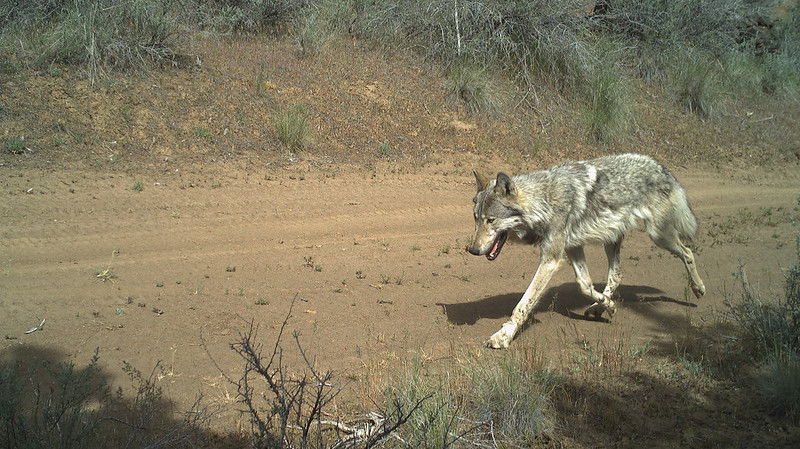Oregon’s wolf population grows to 178; record 24 packs documented; 2 breeding pairs in C.O.

ODFW reports 76 confirmed incidents of livestock depredation, says 'level of illegal wolf take remains unacceptably high'; environmental group dismayed by 'weak population growth'
SALEM, Ore. (KTVZ) -- The minimum count of wolves in Oregon at the end of 2022 was 178, an increase of three over the 2021 minimum known number, with a record 24 packs, according to the Oregon Wolf Conservation and Management annual report released Tuesday by the Oregon Department of Fish and Wildlife.
A record 24 packs were documented (up from 21 last year) and 17 of those packs met the criteria as breeding pairs, with another 14 groups of two or three wolves also identified. Last year also marked the first year that four breeding pairs of wolves were documented in Western Oregon (west of Hwys 97-395).
This annual count is based on verified wolf evidence (like visual observations, tracks, and remote camera photographs). The actual number of wolves in Oregon is higher, as not all individuals present in the state are located during the winter count.
“The population increase in Northeastern Oregon has slowed in some areas as available habitat is filled up and with the turnover of breeding adults in some packs. But wolves are growing in numbers and expanding in distribution in Western Oregon,” said Roblyn Brown, ODFW wolf coordinator. “We are confident in the continued health of the state’s wolf population as they expand in distribution across the state and continue to show an upward population trend.”
At year's end, there were six resident groups of wolves in the Cascades, compared to four groups last year. The number of wolves increased 39 percent in the West Wolf Management Zone (WMZ). Three new packs in the West Zone were successful breeding pairs (Gearhart Mtn in Klamath County, Upper Deschutes in Deschutes County, and Warm Springs in Jefferson County), meaning they produced at least two pups last spring that survived through the end of 2022.
This was the first year that wolves in the West WMZ reached the conservation objective of four breeding pairs. If four breeding pairs are documented at the end of 2023 and 2024, the West WMZ will move into Phase II of the Wolf Plan.
Wolf activity (tracks) was documented in Curry County in the Coast Range after public reports during the fall (though no wolves were documented during the winter count). In addition, an intact radio-collar was found by an ODFW survey crew in a stream in Curry County. The collar had been placed on a Chesnimnus wolf in 2016 that later dispersed to California and last provided information in 2018. The collar was found 45 miles from where wolf tracks were documented last year and the tracks and collar are likely from different individual wolves.
ODFW confirmed 76 incidents of wolf-livestock depredation after 121 investigations, documenting the death of 71 livestock animals and three working dogs. The majority (85 percent) occurred on private land. Consistent with the Wolf Plan, livestock producers implemented non-lethal measures to minimize depredation prior to any department approval of wolf lethal removal. Six wolves were lethally removed in response to chronic depredation in 2022.
The level of illegal wolf take in Oregon remains unacceptably high, with seven wolves illegally killed in 2022, ODFW said. Six cases are still under investigation, but USFWS Office of Law Enforcement and OSP closed the case on the shooting death of a yearling radio-collared wolf in Wheeler County in July. The gray-colored wolf was shot by a man who turned himself in and reported that he misidentified the animal as a coyote. The Wheeler County resident paid a civil fine for unlawfully taking a federally endangered gray wolf.
For more information, see the 2022 Annual Wolf Report online at odfw.com/wolves. For photos of wolves from the Metolius and Gearhart Mtn packs, visit ODFW’s flickr page.
News release from Western Environmental Law Center:
Oregon wolf population stagnates
Today, the Oregon Department of Fish and Wildlife released its wolf conservation and management report for 2022. It shows weak population growth of only three wolves more than the 175 counted in 2021, and a high 17 human-caused wolf mortalities in 2022.
“This is the second year in a row in Oregon we have seen such disheartening numbers in terms of the state’s wolf population, and human-caused mortalities are the main reason behind it,” said Sristi Kamal, deputy director at the Western Environmental Law Center.
“Gray wolves are a resilient species and yet we have seen a mere increase of three individuals this year, and a population increase of a meager 1% for two consecutive years. The report is showing us we are failing to protect wolves as a state.”
“Oregon’s wolf population is very much in recovery, and more than 80% of our wolves do not have any federal or state protections. Poaching, loss of habitat connectivity and climate change impacts on prey-carnivore relationships is proving to be the biggest threat to wolf recovery in Oregon. We need the state fish and wildlife agency and the legislature to take action.”